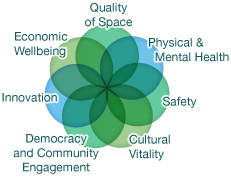Does a community thrive because its citizens are happy? Or are its citizens happy because their community is thriving? Surely, the answer is not a chicken-or-egg equation. Individually and together, citizens create the vibrant community where they can work, play, create, contribute, live in safety, and stay healthy, i.e. a community in which they’re happy.
 The concept of collective community happiness has led Forefront Austin to consider, “Why Does Austin’s Gross Domestic Happiness matter?” This issue of Forefront Austin explores how Austin stacks up on seven happiness measures and who is working to help make everyone happy.
The concept of collective community happiness has led Forefront Austin to consider, “Why Does Austin’s Gross Domestic Happiness matter?” This issue of Forefront Austin explores how Austin stacks up on seven happiness measures and who is working to help make everyone happy.
But first, some background…
Life satisfaction with one’s locale is a concept that’s been building steam since first emerging in 1972 in the Asian kingdom of Bhutan. It has a name, in fact — “Gross National Happiness” or GNH — and, for 40 years, a growing number of private and public sector researchers in cities and countries around the world have sought to quantify a population's GNH. Studies have been conducted in countries of the European Union, Canada and the U.S., South America, and Asia. In its country of origin, Bhutan has even enshrined the concept in its constitution.
In December 2011, the U.S. government joined the GNH movement. Funded by the U.S. Department of Health and Human Services, a panel of experts in psychology and economics began convening to define reliable measures of the nation’s “subjective well-being.” The Washington Post, in a March 2012 story, predicts that the panel’s work could lead to a “measure of happiness (that) could help assess the success or failure of a range of government policies.” The article noted that the Obama administration “has welcomed the effort.”
In April 2012, Gross National Happiness hit the big time. The United Nations released a first-ever World Happiness Report, commissioned for the United Nations’ Conference on Happiness. The report, published by the Earth Institute at Columbia University, concluded that the world’s happiest countries are in Northern Europe — Denmark, Norway, Finland, and the Netherlands; and the least happy are poor countries in Sub-Saharan Africa.
The level of economic security, obviously, is a key factor in these happiness findings, but the U.N. report notes that it’s not just wealth that makes people happy. Political freedom, strong social networks, and an absence of corruption are important. At the individual level, good mental and physical health, someone to count on, job security, and stable families are crucial.
Overall, GNH studies have considered broad and subjective measures, and while these may vary by locale, those of Bhutan are a basic framework of what are considered holistic contributors to happiness — physical, mental and spiritual health; time balance; social and community vitality; cultural vitality; education; living standards; good governance; and ecological vitality.
So is Austin happy, and why does that matter?
Although no official “happiness survey” has been undertaken locally, there is plenty of evidence that Austin has nurtured, and seen a flowering of, happiness factors — and people are noticing. Kiplinger magazine in 2010 cited Austin’s spirit of entrepreneurship in selecting it as the Best City for the Next Decade. The Austin Business Journal has called Austin the third Most Innovative City in the U.S., noting that its high-tech environment is supported by being the fifth most-educated U.S. city. On the health front, Prevention magazine says Austin is among the top 10 Most Walkable U.S. Cities.
Accolades for sure — and only a few of many — but just completed is the City of Austin’s Imagine Austin, a comprehensive initiative that produced a city planning blueprint for the next 30 years. It reflects citizens’ desires for a quality-of-life climate that promotes happiness on civic, economic, and cultural fronts. Perhaps coincidentally, the plan’s Core Principles for Action are aligned with key happiness measures used in GNH studies worldwide, but they do speak to populations’ universal desire for livable cities:
- Grow as a compact, connected city.
- Integrate nature into the city.
- Provide paths to prosperity for all.
- Develop as an affordable and healthy community.
- Manage water and other environmental resources sustainably.
- Think creatively and practice civic creativity.
As the Imagine Austin process got underway, the Core Principles “stood out” from community input, COA Planner Matt Dugan said, noting that wide-ranging citizen input was the plan’s lifeblood.
In a process that began in 2009 and ended with the plan’s adoption by City Council in June 2012, four rounds of community input and a total of 117 meetings, forums, and panel discussions were held. In an expanded role from past planning efforts, social media — Facebook, Twitter and Storify —helped increase citizen participation, to the point that Planner Meredith Bossin said she was “impressed” with its effectiveness in sharing information. In all, Dugan said, the initiative received more than 18,000 “inputs” from citizens.
By all accounts, the Imagine Austin process for gathering citizen input was a success, and it was even named a national "best practice" by the Alliance for Innovation for “Building a Community Vision with Sustained Community Engagement.”
Does Austin measure up?
We conclude with questions. If Austin were to undertake a “happiness study,” what would it take? The community rallied together to build a vision with Imagine Austin. Can it take the next steps to establish measures and develop a plan to improve those measures? Could Imagine Austin be a springboard for new a plan — one that would identify, implement, and track the impact of initiatives designed to keep the city happy, and then align next steps and programs that can increase our baseline score?
Is it time for a community conversation — one that brings public and private sectors together — to assess Austin’s Gross Domestic Happiness, and develop a plan for enriching it?




